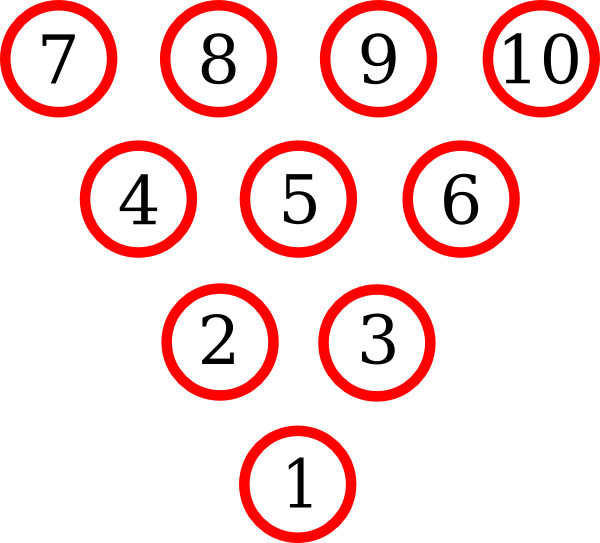Decoding the Bowling Pin Triangle: Strategies for Strikes
Ever wonder why those ten pins are arranged just so? The seemingly simple triangle of bowling pins is a precisely engineered target, and understanding its layout is crucial for any bowler aiming to improve their game. This isn't just about knocking down pins; it's about understanding the physics and geometry behind pin action, optimizing ball trajectory, and ultimately, scoring more strikes. So, let's dive into the fascinating world of bowling pin arrangement.
The standard bowling pin configuration, formally known as the "ten-pin triangle," is more than just a random placement. Each pin is strategically positioned to create a chain reaction, maximizing the potential for a strike. This seemingly static arrangement is a dynamic system, where the force of the bowling ball initiates a cascade of collisions, transferring energy from pin to pin. Mastering this understanding is the key to consistently high scores.
The history of the ten-pin triangle can be traced back to the early days of bowling. While variations existed, the current configuration emerged as the standard, optimizing the balance between challenge and reward. This arrangement provides a sufficient target size for beginners while simultaneously demanding precision and strategy for more experienced bowlers. The importance of the pin layout is evident in the numerous resources and strategies developed around it, demonstrating its integral role in the sport.
A central issue related to the ten-pin layout is the concept of "pocket hitting." The pocket is the space between the head pin (the front pin) and either the 2-pin or 3-pin, depending on whether the bowler is right-handed or left-handed. Hitting the pocket at the correct angle and with the right amount of ball speed and rotation is crucial for generating strikes. Understanding the precise location of the pocket in relation to the pin setup is essential for consistent strikes.
The ten pins are numbered 1 through 10, with the head pin at the front designated as number 1. The remaining pins are arranged in rows behind the head pin, forming a triangular shape. The pins are placed equidistant from each other within their respective rows. This specific spacing and arrangement are carefully calibrated to create the desired chain reaction upon impact. Understanding this numbering system is important for analyzing pin action and identifying areas for improvement.
One benefit of understanding the pin layout is the ability to target specific pins for spares. By visualizing the angles and trajectories required to knock down specific pins, bowlers can develop a more strategic approach to spare shooting. Another advantage is improved consistency in hitting the pocket. A deep understanding of the pin placement allows bowlers to adjust their aiming point and ball delivery to consistently target the pocket, leading to more strikes. Lastly, understanding the pin layout can help analyze and diagnose flaws in one's bowling technique, leading to more effective practice and improvement.
Advantages and Disadvantages of Understanding Pin Placement
| Advantages | Disadvantages |
|---|---|
| Improved strike percentage | Can be overwhelming for beginners |
| Better spare shooting | Requires practice and analysis |
| Enhanced understanding of ball physics | No direct impact on physical ability |
Best Practice 1: Visualize the pocket. Before each shot, take a moment to visualize the pocket in relation to the pin setup. This mental rehearsal can help improve accuracy and consistency.
Best Practice 2: Practice your targeting. Use markers or visual aids on the lane to practice aiming at specific points on the pin deck. This can help refine your aim and improve your ability to hit the pocket consistently.
Best Practice 3: Analyze your shots. Pay attention to the pin action after each shot and try to understand how your ball delivery affected the outcome. This analysis can help identify areas for improvement in your technique.
Best Practice 4: Experiment with different angles and ball speeds. Don't be afraid to try different approaches to find what works best for you. Experimenting with different ball speeds, release angles, and amounts of rotation can help you find the optimal strategy for your bowling style.
Best Practice 5: Seek guidance from experienced bowlers or coaches. Learning from those with more experience can provide valuable insights and accelerate your learning process. They can offer personalized advice and help you identify specific areas for improvement in your game.
FAQ 1: What is the purpose of the pin numbering system? Answer: The numbering system helps bowlers identify specific pins for targeting and analyzing pin action.
In conclusion, the bowling pin placement diagram, often overlooked, is a critical element in the sport of bowling. Understanding the layout, the physics involved, and the strategic implications of pin placement can significantly enhance a bowler's performance. From increasing strike percentage to improving spare shooting, the benefits are numerous. While mastering the nuances of pin action requires practice and analysis, the rewards are well worth the effort. So, next time you step up to the lane, take a moment to appreciate the intricacy of that seemingly simple triangle of pins. It’s the key to unlocking your bowling potential. Strive to incorporate the best practices mentioned, analyze your performance, and continue learning to elevate your game. Bowling is not merely about throwing a ball; it's about strategy, precision, and understanding the physics of the game. The bowling pin placement diagram is your roadmap to success.
Transform your landscape with cobblestones a comprehensive guide
Unlocking brighter spaces exploring sw natural choice lrv
Tuesday cat pictures a purrfect start to your day














